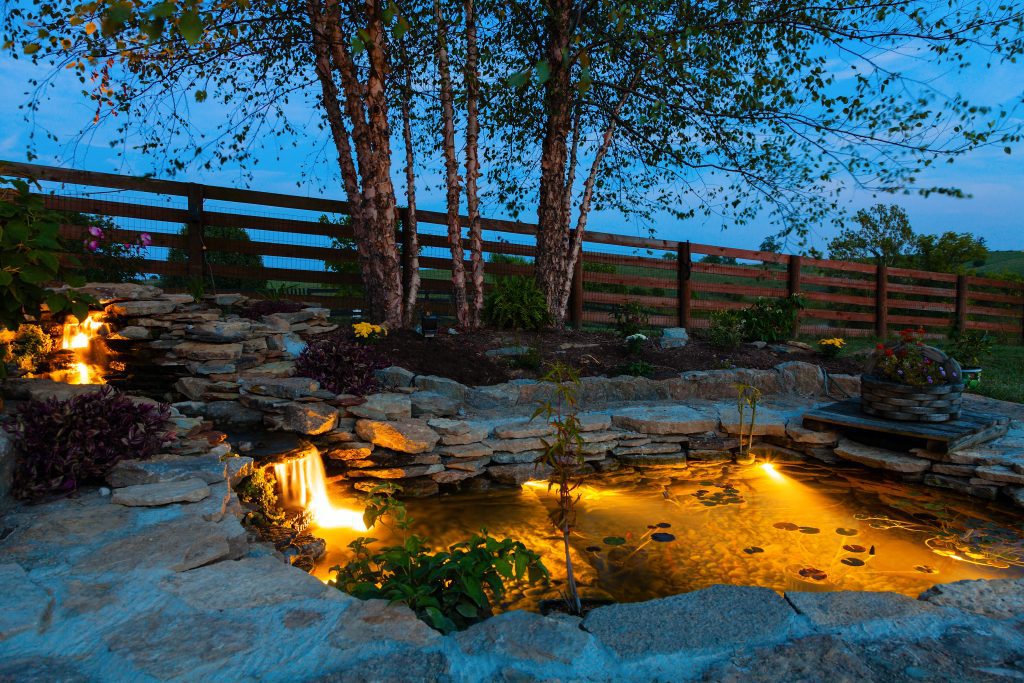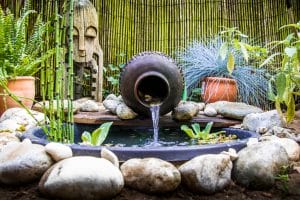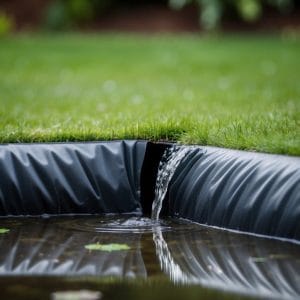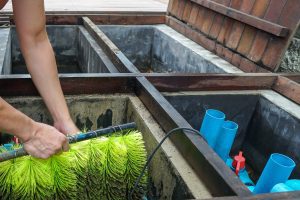
How to Beautifully Illuminate Your Pond with Pond Lighting: Expert Tips for Glowing Waters
Adding lighting to a garden pond can turn a simple feature into a stunning centrepiece. By choosing the right pond lighting, anyone can create a magical atmosphere in their backyard. Careful placement of lights enhances the beauty of the water and surrounding plants while providing a serene spot to relax.
For a natural look, some might opt for soft, subtle lights that mimic moonlight, while others may prefer bold colours to make their pond stand out. Pond lights can be used to highlight special features like waterfall stones or unique plant arrangements. These choices can dramatically change how a garden pond is experienced during the evening.
Visibility is key, not only for aesthetics but also for safety. Illuminating paths around the pond ensures easy navigation, so guests can safely enjoy the view. Good lighting can transform a dark garden pond into a welcoming oasis.
Understanding Pond Lighting Basics
Pond lighting transforms a garden feature into a captivating night-time scene. The right choice of lights boosts visual appeal while enhancing the natural beauty of the environment.
Types of Pond Lights
There are various types of pond lights available. Underwater lights are installed beneath the water’s surface, creating shimmering reflections and highlighting aquatic plants. They add a magical glow to the water, making it look surreal and enchanting.
LED lights are energy-efficient and come in many colours. They offer both vibrant and subtle lighting options, allowing for customisation based on the desired ambience. Floating lights rest on the pond surface. These are movable, making them ideal for flexible design changes.
Each type of light contributes uniquely to the pond’s appearance. Selecting the right combination can beautifully enhance the pond.
Benefits of Pond Illumination
Illuminating a pond makes it an attractive feature, even at night. The lights highlight the water and surrounding landscape, drawing attention to its beauty. This adds a unique visual appeal that changes the feel of a garden after dark.
Pond lights can also improve safety. They illuminate pathways and edges, reducing the risk of trips or falls when walking near the water. Moreover, lights deter unwanted wildlife and increase security by making the area more visible.
Overall, pond lighting improves the ambience, safety, and enjoyment of garden spaces.
Designing Your Pond Lighting Scheme
Creating a captivating pond lighting scene involves thoughtfully choosing light types, strategic placements, and understanding your pond’s unique features. A well-designed scheme enhances your pond’s appearance and can highlight specific areas for a stunning night-time view.
Determining Your Pond’s Design
Before selecting lights, consider the pond’s shape, size, and features. Identify focal points like waterfalls, sculptures, or unique plants. Each point will need tailored lighting to truly stand out.
Understand how the natural layout of rocks and plants influences light dispersion. Consider the pond’s depth and the surrounding landscape. This information helps in picking lights that match and enhance the pond’s natural design.
Choosing the Right Light for Each Feature
Different water features require specific lighting types. For a waterfall, lights placed underneath can create a glowing effect. Floating lights are ideal for open water areas, providing gentle illumination.
Sculptures may benefit from spotlights that cast focused beams. Similarly, LED lights can be placed around plants to enhance their natural beauty, offering vivid yet unobtrusive lighting.
Light Placement and Beam Angles
The placement of lights and the angle of beams play crucial roles in achieving the desired effect. Position lights at the edge of the pond to create balanced illumination. This setup minimises glare and highlights the pond’s edges effectively.
Choose beam angles carefully. Narrow beams focus on specific features, while wider beams create ambient light. Be mindful of the light’s distance from each feature to control brightness and shadow. Adjusting these elements creates depth and mood in the pond’s night-time appearance.
Types of Pond Lighting Systems
Pond lighting can transform a regular garden pond into a stunning night-time feature. Different types of lighting systems offer unique benefits, from energy efficiency to aesthetic appeal.
LED Pond Lighting Solutions
LED pond lights are popular for their energy efficiency and long lifespan. These lights consume less power, which reduces electricity bills. They also come in a variety of colours and designs, allowing homeowners to customise the look of their pond.
Submersible lights are a common LED option and can be placed underwater to create beautiful effects by illuminating the pond from below. LEDs are durable, making them suitable for outdoor conditions. This means less maintenance and replacement over time, providing peace of mind.
Solar Pond Lighting Options
Solar pond lights utilise solar energy, making them an eco-friendly choice. During the day, they absorb sunlight and convert it into energy, which they use to light the pond at night. These lights eliminate the need for electrical wiring, making installation easy and reducing running costs.
Solar lights are ideal for remote locations where power access is limited. They are also safe since they don’t rely on electricity. Cloudy days might affect their performance, but many models come with built-in batteries to store extra energy for such times.
Halogen and Other Lighting Solutions
Halogen lights offer a bright and warm light, enhancing the natural features of a pond. They are known for their intensity and can create dramatic effects when used in landscaping. Despite being less energy-efficient than LEDs, they are still a viable option for those seeking a different lighting effect.
Other options include fibre optic lights that provide versatile and flexible lighting solutions. These can be used to create intricate patterns and are perfect for highlighting specific features. Each lighting system has its pros and cons, so it’s important to consider what fits best with the specific needs and aesthetic of the pond.
Installing Pond Lights
Installing pond lights adds both beauty and safety to outdoor spaces. Key areas to consider include electrical connections and proper waterproofing, ensuring longevity and performance while preventing any safety hazards.
Wiring and Electrical Safety
Wiring pond lights safely is crucial. Start by planning the layout and measuring the distance to the power source to ensure you have enough cable. Use outdoor-rated, low-voltage wiring when possible to reduce electrical risks. Low-voltage transformers, typically 12 volts, are safer around water.
Label and secure all connections firmly using waterproof connectors or gel-filled wire nuts. Circuit breakers and ground fault circuit interrupters (GFCIs) should be included to prevent electrical shocks. Hiring a professional electrician guarantees adherence to electrical codes.
Waterproofing and IP Rating
Pond lights must be waterproof to function properly and safely. When selecting lights, check for the IP rating, which indicates the protection level against water and dust. For pond use, an IP68 rating is recommended as it allows for continuous submersion.
Ensure all joints and connections are sealed with waterproof materials. Silicone sealant can be used around any exposed areas. Submersible fixtures should especially have robust sealing to prevent water ingress. Regularly inspect and maintain the seals to ensure durability.
Achieving the Desired Lighting Effects
Consider different types of lighting effects like uplights and submersible lights to create dynamic visuals. Experiment with angles and positions to highlight pond features such as rocks, fountains, or plants. Use multiple light sources for layered effects.
Coloured lenses or RGB LED lights can create vibrant accents in the water. Balance brightness to avoid over-illumination, offering a serene and inviting atmosphere instead. Test various settings to find what works best with your outdoor aesthetic.
Maintenance and Care for Your Pond Lighting
Proper maintenance is crucial to ensure your pond lighting remains effective and safe. Regular checks can help prevent common issues and reduce the electricity bill.
Routine Maintenance Tips
Start by checking the lighting fixtures regularly. Look for any signs of wear or damage. Replace broken bulbs immediately to maintain brightness and performance. Clean the lights and surrounding areas to prevent algae and dirt build-up. Use a soft brush or cloth to clean without scratching.
Inspect the wiring and connections for corrosion or wear, ensuring all are sealed tightly. This helps prevent water damage and potential electrical hazards. Verify that all lights are operating as intended. Regular checks can identify problems before they become significant issues, saving time and expenses in the long run.
Solving Common Lighting Issues
Flickering lights can be frustrating. This may be due to loose connections or faulty bulbs. First, ensure all connections are tight and secure. If flickering persists, consider replacing the bulb or checking the power supply.
Water ingress is another common issue. Check for damaged seals or cracks in the fixtures. Replace any compromised parts to prevent water from entering and damaging the lights.
An unexpected increase in the electricity bill can be worrying. Test the timer settings and the efficiency of the light bulbs. Switching to LED bulbs can help reduce energy consumption significantly. Regular inspections and adjustments can mitigate these common issues.
Creative Lighting Ideas and Enhancements
Bringing a pond to life at night involves more than just installing lights. It requires creativity and thoughtful enhancements to make the space magical. By using innovative lighting ideas like cool and warm white lights, and focusing on distinct features and adapting lighting to different occasions, a pond can become a stunning night-time feature.
Innovative Lighting Solutions
When lighting a pond, choosing the right colour and type of light is essential. Cool white lights can create a modern and sleek look. Warm white lights, on the other hand, offer a cosy and inviting atmosphere.
Submersible lights are popular for ponds as they showcase underwater features. Some homeowners like using LED lights for energy efficiency and flexibility. They can be placed strategically to highlight paths or the pond’s perimeter.
Accentuating Pond Features
Lighting helps emphasise unique elements. Waterfall lighting can make moving water shine, creating captivating effects. This can be achieved with spotlights focused directly on the waterfall. Floating lights on the pond’s surface bring a soft glow and can be an attractive element.
Illuminating statues or plants surrounding the pond adds depth and dimension. Accent lighting can focus on rocks or bridges, highlighting textures and forms, making the whole scene visually engaging.
Adapting Lighting for Events and Seasons
A pond can change its look to match events or seasons. Coloured lights can add variety for special occasions like parties or holidays. These can be simple to install and change, allowing quick transformations.
During the festive season, adding lights that resemble fairy lights or employing subtle, themed light displays can create a magical atmosphere. Seasonal adjustments, such as warmer tones in winter or brighter lights in summer, cater to different moods and celebrations.
By tailoring lighting for specific days or weather conditions, a pond becomes a flexible feature that adds to the enjoyment of any gathering or quiet night.
Specialty and Decorative Pond Lighting
Specialty and decorative lighting options can transform a pond into a magical display. It often combines aesthetics with functionality, providing beauty and improving visibility at night.
Floating Lily Pad Lights and Solar-Powered Floats
Floating lily pad lights add a whimsical touch to any pond. These lights mimic real lily pads, offering a natural look while providing gentle illumination. They enhance the pond’s aesthetic, often changing colours for varied effects.
Solar-powered floating lights are environmentally friendly and cost-efficient. They charge during the day and light up automatically at night, saving on electricity bills. No wiring is required, making them easy to install and maintain. These lights are perfect for those who want a peaceful and serene pond atmosphere.
String Lights and Spotlight Features
String lights, often draped around the edges, create a charming ambience. They are ideal for framing the pond, highlighting its shape and creating a cosy feel for evening gatherings. Waterproof options are available to withstand different weather conditions.
Spotlights can be used to focus on specific features in the pond. They highlight plants, fountains, or statues, drawing attention to these spots. Submersible spotlights can be placed underwater, adding depth and dimension to the scene. These features are perfect for creating dramatic effects in any pond setting.
Illuminating Aquatic Life
Illuminating aquatic life helps showcase the diverse inhabitants of the pond. Clear lights, placed strategically, can highlight fish and plants without disturbing them.
Using soft, warm lights can create a natural environment that makes fish visible at night. Submersible lights allow viewers to see beneath the surface, revealing the vibrant movement of fish and the sway of plants. Enhanced visibility can make night-time pond viewing a captivating experience for all.
Energy Efficiency and Cost-Effectiveness
Pond lighting can be energy-efficient and cost-effective with the right choices. Exploring factors like types of lights and potential savings is essential.
LED vs. Solar vs. Halogen Lights
LED Lights: Known for their energy efficiency, LED pond lights use less power and last longer than traditional options. They produce minimal heat, making them safe for pond ecosystems. LEDs are available in various colours and can often be adjusted for brightness.
Solar Lights: Solar-powered lights are another eco-friendly choice. They use sunlight to charge during the day, saving electricity. Installation is simple as no wiring is required, but performance can vary depending on sunlight exposure. Cloudy days might affect their brightness and duration.
Halogen Lights: Halogen lights are less energy-efficient compared to LEDs and solar lights. They consume more power, generating more heat, which might disturb the pond environment. Their higher electricity usage could lead to increased bills, despite their lower upfront cost.
Reducing the Electricity Bill
Embracing LED or solar pond lighting can significantly cut electricity costs. LEDs consume less energy and require less frequent replacements, contributing to lower long-term expenses. Solar lights offer savings on electricity bills as they rely on sunlight rather than electrical power.
Timers and motion sensors can also help manage lighting usage, ensuring lights are only active when needed. This can prevent unnecessary energy consumption at times when the pond doesn’t require illumination. Investing in quality lighting can bring substantial savings over time.
Cost-Benefit Analysis of Pond Lighting
Switching to energy-efficient pond lighting ultimately offers financial benefits. Though LED and solar lights might have a higher initial cost, their longevity and minimal energy usage offset this expense over time. LEDs, for instance, last much longer, reducing replacement needs and associated costs.
Solar pond lights, while dependent on sunlight, eliminate ongoing electricity expenses. Consideration of local climate is important when evaluating solar lighting viability. Properly choosing and maintaining pond lights can lead to long-term savings and a reduced environmental impact, making them a cost-effective solution.
Safety and Regulations
When setting up pond lighting, there are important safety standards and local regulations to follow. Proper installation helps prevent accidents and ensures everything operates smoothly.
Understanding Electrical Safety Standards
Electrical safety is crucial when installing pond lighting. Water and electricity are dangerous together, so using Low Voltage lights is recommended. This reduces the risk of electrical shock. Always use waterproof fixtures and cables rated for outdoor use.
Install Residual Current Devices (RCDs) for additional protection. These shut off electricity if they detect a fault. Regular inspections are essential to check for wear and tear, especially with cables. This helps prevent failures and keeps the system safe.
Compliance with Local Regulations
Local regulations often dictate what is permissible regarding lighting setup. It’s important to check with the local council or relevant authorities before installation. They may have specific rules on the positioning and brightness of lights to preserve local wildlife and prevent light pollution.
Some areas may require permits for larger installations. Inspectors might need to approve the lighting, ensuring it meets local codes. Always keep documentation of the equipment used and any correspondence with authorities. This ensures compliance and provides a record if needed in the future.
Enhancing Nighttime Pond Experience
Transforming a pond with lighting can make evenings in the garden magical. Proper illumination highlights water features and sets the mood for night-time fun.
Lighting for Nighttime Activities
Adding lights to a pond creates more opportunities for evening activities. Underwater lights can spotlight swimming fish and moving water, which is great for those who like to relax by the pond.
Pathway lights guide safely at night, making late strolls by the pond enjoyable. For those who entertain, consider spotlights around the pond to light up seating areas. This makes it easy for guests to navigate while providing a soft glow for conversation.
For sport enthusiasts, well-placed lights around the pond ensure everyone can safely enjoy activities without any mishaps.
Creating an Illuminated Ambiance
An illuminated pond adds an enchanting feel to any garden setting. Using coloured lights can set the mood for tranquillity or celebration. Soft white lights mimic moonlight, which enhances natural beauty.
It is vital to use energy-efficient bulbs to keep lighting eco-friendly. Solar-powered lights are a good choice, as they are sustainable and simple to install.
Placing lights around foliage frames the pond, adding depth and dimension. Allowing light to reflect off the water creates shimmering effects that are mesmerising to watch. This setup transforms any pond into a captivating night-time spectacle.



